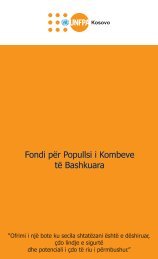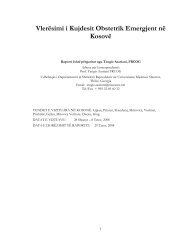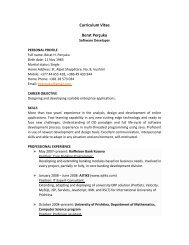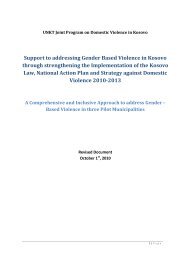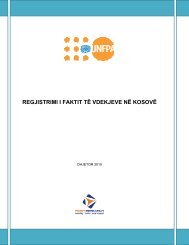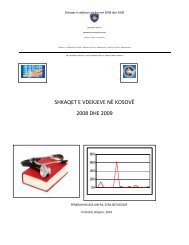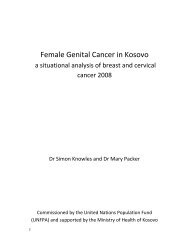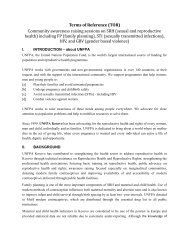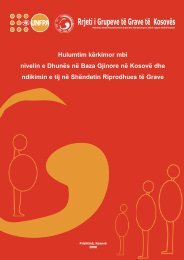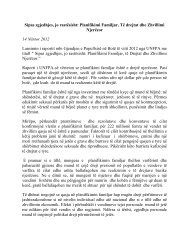perinatal situation in kosovo for years 2000 â 2004 - UNFPA
perinatal situation in kosovo for years 2000 â 2004 - UNFPA
perinatal situation in kosovo for years 2000 â 2004 - UNFPA
Create successful ePaper yourself
Turn your PDF publications into a flip-book with our unique Google optimized e-Paper software.
Introduction<br />
In 1999, Kosovo came under the adm<strong>in</strong>istration of the United Nations Mission <strong>in</strong><br />
Kosovo - UNMIK <strong>in</strong> partnership with the European Union (EU) and the Organization <strong>for</strong><br />
Security and Cooperation <strong>in</strong> Europe (OSCE).<br />
Kosovo covers an area of 10.908 km 2 and its population is 2.1 million accord<strong>in</strong>g to the<br />
projections by UNMIK <strong>for</strong> <strong>2000</strong> elections. Although accurate data is not available<br />
estimated age breakdown of the population is given <strong>in</strong> Table 1 below:<br />
Table 1. General population figures by age groups <strong>in</strong> Kosovo, <strong>2000</strong><br />
Total<br />
population<br />
Population aged<br />
less than 15<br />
<strong>years</strong><br />
Population aged<br />
less than 5<br />
<strong>years</strong><br />
Population<br />
aged less than<br />
1 year<br />
Number of<br />
persons<br />
Percentage of<br />
Total<br />
population<br />
2.105.000 736.750 252.600 46.310<br />
100 % 35 % 12 % 2.2 %<br />
Kosovo is characterized by a lack of accurate demographic data. The last commonly<br />
accepted census <strong>in</strong> Kosovo took place <strong>in</strong> 1981. Based on estimates Kosovo has a<br />
population of over 2 million.<br />
The maternal, <strong>per<strong>in</strong>atal</strong>, <strong>in</strong>fant and child health status of Kosovo’s women and children<br />
is poor compared to the rest of Europe. The high maternal, <strong>per<strong>in</strong>atal</strong> and <strong>in</strong>fant mortality<br />
rates reflect the need to improve the accessibility, utilization and quality of services <strong>for</strong><br />
the prevention, detection and treatment of the health problems that occur dur<strong>in</strong>g<br />
pregnancy, childbirth and <strong>in</strong>fancy.<br />
The <strong>in</strong>fant mortality rate (IMR) is estimated at 49 per 1,000 live births (Demographic<br />
and Health Survey – DHS 2003) while under 5 mortality rate is 69 per 1000. Per<strong>in</strong>atal<br />
mortality rate <strong>for</strong> year <strong>2004</strong> is 25.6 per 1000 show<strong>in</strong>g decl<strong>in</strong>e trend from 29.1 <strong>for</strong><br />
1000 <strong>in</strong> year <strong>2000</strong>.<br />
Average growth rate is estimated to be 2.01%. It is also estimated that 26% of the<br />
population are women of childbear<strong>in</strong>g age.<br />
The population of Kosovo is young, with a mean age of 25 <strong>years</strong>. Over half of the<br />
population is under 25 <strong>years</strong> of age and only eight per cent is over 60. Women of<br />
childbear<strong>in</strong>g age (15-45 <strong>years</strong>) constitute 56% of the female population. The average<br />
number of people per household is 7.<br />
In year <strong>2000</strong> issued UNMIK Regulation No. <strong>2000</strong>/10 authorized the <strong>for</strong>mer Department<br />
of Health and Social Welfare to develop policies <strong>for</strong> health. Based on this, the<br />
Department of Health has issued the “Health Policy <strong>for</strong> Kosovo - 2001” to guide the<br />
development of Kosovo’s health care and the first objective of the policy is Health Start<br />
<strong>in</strong> Life.<br />
Economically, Kosovo is one of the least developed and poorest regions <strong>in</strong> Europe. The<br />
lack of economic development also impacts the health sector, with most <strong>in</strong>dicators not<br />
<strong>in</strong> l<strong>in</strong>e with developed countries. The Gross Domestic Product (GDP) per capita <strong>in</strong> 2003<br />
is 790 USD. Recent World Bank data show that the number of people liv<strong>in</strong>g <strong>in</strong> absolute<br />
2



